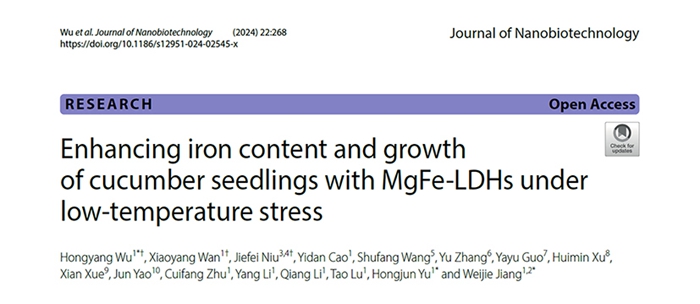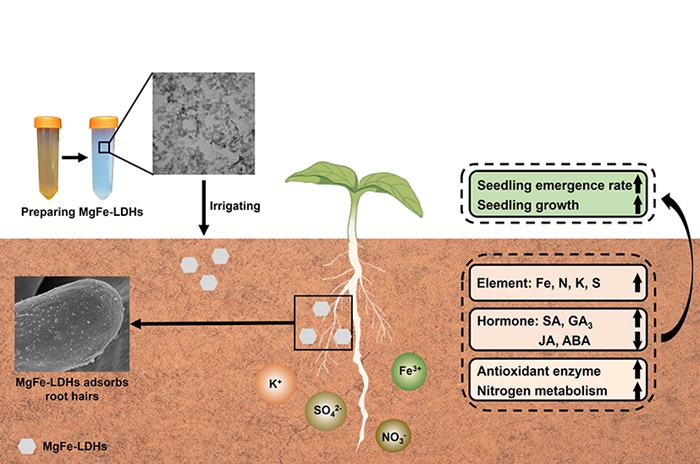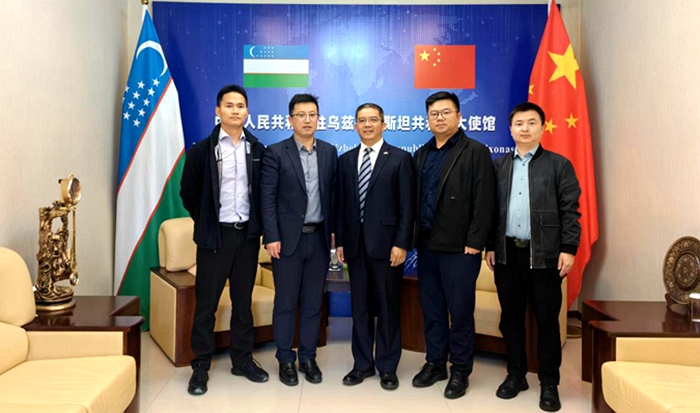IVF-CAAS Discovers MgFe-LDHs Enhance Cucumber Seedling Growth and Iron Uptake
Recently, the innovation team of vegetable cultivation and physiology of the Institute of Vegetables and Flowers (IVF) of the Chinese Academy of Agricultural Sciences (CAAS) published a research paper entitled "Enhancing iron content and growth of cucumber seedlings with MgFe-LDHs under low-temperature stress" in the journal Journal of Nanobiotechnology (IF=10.2, Q1). This research marks the first application of MgFe-LDHs to plant nutrition, demonstrating their ability to promote the growth of cucumber seedlings and enhance iron absorption, paving the way for LDHs nano-fertilizer development.

In soils and growing media, insoluble iron forms are hard for plants to use, leading to widespread iron deficiency affecting ~2 billion people, especially among the poor. Chelated iron helps, but is costly and can harm the environment & crop growth. There's a need for better iron fertilizers to tackle "hidden hunger." Layered double hydroxides (LDHs), a type of two-dimensional nanomaterial, are used in life sciences & medicine, and show promise in plant research, but their potential as nano-fertilizers to enhance plant nutrition hasn't been explored, offering a new avenue for future research.

Figure 1 TOC graphics
In this study, MgFe-LDHs nanomaterials were synthesized and characterized. Through seed germination and water absorption experiments, a concentration of 10 mg/L was identified as having the most significant effect on the germination of cucumber seeds. Subsequently, pre-germinated cucumber seeds were sown in a solar greenhouse and irrigated with the identified concentration, with only water supplemented during the cultivation period. After ten days, a notable improvement in the emergence rate and growth of the cucumber seedlings was observed. Analysis of temperature control data and ultra-thin section results indicated that the cucumber seedlings were subjected to low-temperature stress. Simulated experiments at low and normal temperatures in an artificial climate chamber confirmed that MgFe-LDHs could promote the emergence rate and growth of cucumber under low-temperature stress. Furthermore, this study employed SEM, TEM, FTIR, and ICP-OES techniques to investigate the cellular fate of MgFe-LDHs within cucumber seedlings. The findings indicated that MgFe-LDHs can adsorb onto the surface of mature root hairs, thereby improving the absorption of nutrients such as Fe, N, K, S, and increasing the accumulation of these elements in the seedlings. Integrating plant physiology, molecular biology experiments, and transcriptomics validation, the study revealed the potential molecular mechanisms by which MgFe-LDHs promote seed emergence, resist low-temperature stress, and enhance nutrient uptake. Specifically, MgFe-LDHs were found to significantly increase SA content, enhancing the expression of the CsFAD3 gene, increase GA3 content, promoting nitrogen metabolism and protein synthesis, and reduce ABA and JA hormone content, thereby alleviating inhibition on seed germination and seedling growth.
This work was funded by the National Key Research and Development Program, and the National Key Vegetable Industry Technology System of China.
More information can be found through the link:
https://jnanobiotechnology.biomedcentral.com/articles/10.1186/s12951-024-02545-x
By Hongyang Wu(wuhongyang@caas.cn)
-
 May 11, 2024WRI Deepens Agricultural Technology Cooperation with Agricultural Research Institutions in Uzbekistan
May 11, 2024WRI Deepens Agricultural Technology Cooperation with Agricultural Research Institutions in Uzbekistan -
 Apr 28, 2024CAAS President Meets President of Murdoch University
Apr 28, 2024CAAS President Meets President of Murdoch University -
 Apr 18, 2024Opening Ceremony of the Training Workshop on Wheat Head Scab Resistance Breeding and Pest Control in Africa Held in CAAS
Apr 18, 2024Opening Ceremony of the Training Workshop on Wheat Head Scab Resistance Breeding and Pest Control in Africa Held in CAAS -
 Apr 03, 2024IPPCAAS Co-organized the Training Workshop on Management and Application of Biopesticides in Nepal
Apr 03, 2024IPPCAAS Co-organized the Training Workshop on Management and Application of Biopesticides in Nepal -
 Mar 28, 2024Delegation from the School of Agriculture and Food Science of University College Dublin, Ireland Visit to IAS, CAAS
Mar 28, 2024Delegation from the School of Agriculture and Food Science of University College Dublin, Ireland Visit to IAS, CAAS
